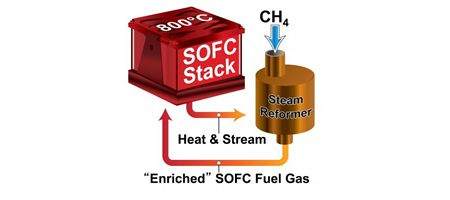Individual homes could soon be powered with their own solid oxide fuel cell systems, thanks to a breakthrough in performance.

The new system, from the Department of Energy’s Pacific Northwest National Laboratory (PNNL), achieves up to 57 percent efficiency – half as good again as previous versions of the same size. With a few small adjustments, they say, the efficiency could hit 60 percent.
It uses methane as fuel, and is designed for individual houses or neighborhoods.
“Solid oxide fuels cells are a promising technology for providing clean, efficient energy. But, until now, most people have focused on larger systems that produce 1 megawatt of power or more and can replace traditional power plants,” says Vincent Sprenkle, chief engineer of PNNL’s solid oxide fuel cell development program.
“However, this research shows that smaller solid oxide fuel cells that generate between 1 and 100 kilowatts of power are a viable option for highly efficient, localized power generation.”
Sprenkle’s pilot system generates about 2 kW of electricity, about the amount a typical American home consumes. But it can be scaled up to produce between 100 and 250 kW, which could provide power for about 50 to 100 homes.
To achieve the improved efficiency, the team first used a process called external steam reforming. Steam mixes and reacts with the fuel, creating carbon monoxide and hydrogen, which then react with oxygen at the fuel cell’s anode and generate electricity.
Unlike previous designs, PNNL’s uses external steam reforming, which completes the initial reactions between steam and the fuel outside of the fuel cell. This means that, thanks to new, multiple heat exchangers, heat doesn’t cause uneven temperatures on the ceramic layers that can potentially weaken and break the cell.
The second unique aspect of the system is that it recycles, using the exhaust from the anode – made up of steam and heat byproducts – to maintain the steam reforming process.
“There still are significant efforts required to reduce the overall cost to a point where it is economical for distributed generation applications,” says Sprenkle.
“However, this demonstration does provide an excellent blueprint on how to build a system that could increase electricity generation while reducing carbon emissions.”






